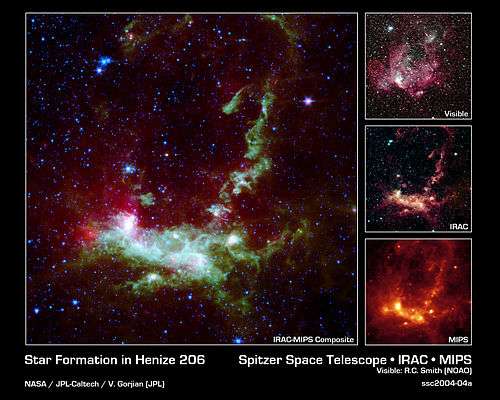Henize 206
Henize 206[p] is a nebula in the Large Magellanic Cloud.[1] This luminous cloud of gas and dust houses a cluster of newborn stars. Although Henize 206 was first catalogued in the 1950s, it was reported in NASA press releases in March 2004, for showing several example images generated from the various infrared cameras on the Spitzer Space Telescope launched in August 2003.[1]
Photos
The nebula, Henize 206, and the scattered remnants of the exploding star that created it,[1] are pictured in detail in images from NASA's Spitzer Space Telescope (see image below). Henize 206 lies in a satellite galaxy outside the Milky Way galaxy, nearly 163,000 light-years away, called the Large Magellanic Cloud. The nebula is home to hundreds and possibly thousands of stars, ranging in age from two to 10 million years old.[1]

The Spitzer images provide a detailed snapshot[1] of this universal phenomenon of star formation. By imaging Henize 206 in infrared wavelengths, Spitzer was able to see through blankets of dust that dominate visible light views. The image was converted into a conventional photo by reassigning visible colors to the infrared data. The resulting false-color image shows embedded young stars as bright white spots, with the surrounding gas and dust in blue, green and red. Also shown, in the nebula image, is a ring of green gas, which indicates the wake of the ancient supernova's explosion.
Formation and composition
According to theories of stellar formation, as in other stellar nurseries, the stars in Henize 206 were created after a dying star, or supernova, exploded, sending intense shockwaves through clouds of cosmic gas and dust.[1] The gas and dust were subsequently compressed into large groups, then gravity further condensed them into massive objects, and stars were born. Eventually, some of the stars are expected to die in a fiery blast, triggering another cycle of stellar birth and death. This recycling of stellar dust and gas appears to occur throughout the Universe. Earth's own Sun is considered to have descended from multiple generations of stars, as evidenced by heavy elements found, in the Solar System, in concentrations too large for a first-time star.
Detailed observations of a star cluster nebula provide astronomers with a laboratory for understanding the early universe, and stellar birth and death cycles. Unlike larger galaxies, the Large Magellanic Cloud has a quirk. The gas permeating it contains roughly 20 to 50 percent of the heavier elements,[1] such as iron, possessed by the Sun and gas clouds in the Milky Way. This low-metallicity state approximates the predicted chemical composition of the early Universe, allowing astronomers to compare what stellar life was like billions of years ago, when heavy metals were scarce.[1]
Henize 206 was first catalogued in the early 1950s by Dr. Karl Henize,[1] an astronomer who became a NASA astronaut. He flew during the Spacelab-2 mission, aboard the Space Shuttle Challenger in July/August 1985. He died in 1993, at age 66, while climbing Mount Everest.[1]
Launched on August 25, 2003, from Cape Canaveral, Florida, the Spitzer Space Telescope[1] is the fourth of NASA's Great Observatories. The other 3 are the Hubble Space Telescope, the Chandra X-ray Observatory and Compton Gamma Ray Observatory. JPL in Pasadena, CA manages the Spitzer Space Telescope mission for NASA's Office of Space Science, in Washington, D.C. The science operations are conducted at the Spitzer Science Center at the California Institute of Technology (Catech) in Pasadena, which manages JPL.[1]
References
[p] - The name "Henize 206" is pronounced as "hen-eyes" after astronomer Karl Henize.[1]